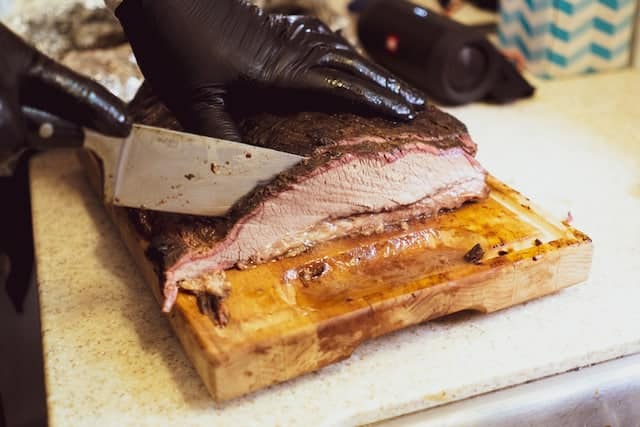Like any other barbecue lover, I’m biased when it comes to smoking meat. If you ask me, there’s simply no better way to cook meat. But I would be lying if I told you smoking doesn’t present its own unique set of challenges. One of the most common issues I see smokers struggling with is how to keep their meat moist while smoking.
There are at least a dozen methods you can use to prevent your meat from drying out during the smoking process:
- Choose your cut of meat wisely
- Season with salt
- Wrap meat in aluminum foil
- Monitor smoking temperature
- Baste or spray your meat
- Avoid using too much smoke
- Use a bowl or tray of water
- Keep the lid closed
- Use indirect heat
- Marinate your meat
- Use more wood, less charcoal
- Rest your meat
In this article, I explore each of these methods to help you understand what it takes to keep your barbecue moist and tender. If you’ve ever felt the disappointment of biting into a piece of dry brisket or pork shoulder, keep reading! By following even a few of the methods in this list, you’ll never experience dry meat again.
1. Choose your cut of meat wisely
This is, without a doubt, the most crucial method on this list. You can try everything to keep your meat moist, but, if you start with a bad cut of meat, nothing is going to help. When choosing your meat, don’t be cheap. A good lean-to-fat ratio is crucial for cooking meat that is moist and tender. Whichever meat you plan to smoke, do some research and make sure you’re getting a top-quality cut.
2. Season with salt
Dry rubs are an essential weapon in any pit master’s arsenal. A perfect balance of spices will bring out flavors in your meat you never thought possible. Salt is not only great for enhancing flavor, but it also helps to preserve your meat’s moisture. This is due to a process called “denaturing,” which the salt initiates. So, whether you’re purchasing your dry rub or mixing your own at home, make sure salt is included.
3. Wrap your meat in aluminum foil
Aluminum foil is a fantastic insulator. Wrapping your meat in foil will prevent moisture from escaping. The trick is to make sure and wrap your meat so that there are no gaps in the foil through which steam could escape.
However, there is one drawback to using foil. While foil does an amazing job of trapping moisture, it’s also incredibly effective at keeping smoke from getting in. If you still want that smoked flavor, don’t wrap your meat in foil before putting it in the smoker. Instead, leave it exposed on the rack for a while before wrapping.
4. Monitor your smoking temperature
A big mistake I see smokers make is setting and forgetting. This is where you bring your smoker up to the desired temperature, throw your meat on, and simply walk away. Smoking is an art, not a science. If you want moist, tender meat, you’re going to have to work for it. This means constantly monitoring your smoker to ensure that the temperature remains even throughout the smoking process. When smoking, you typically want to keep your temperature around 225 to 245 Fahrenheit. If left unattended, smokers can increase or decrease in temperature, leading to uneven cooking and dry meat.
5. Baste or spray your meat
If you like your barbecue on the saucy side, basting or spraying your meat throughout the smoking process is not only great for adding flavor, but also helps by adding moisture to your meat. What you use to baste or spray depends on what style of barbecue you’re after. For a Kansas City style, consider brushing your meat occasionally with a sticky sauce. For Carolina style, some pitmasters spray their meat with apple cider vinegar. But there are plenty more basting and spraying options out there. Choose the one that’s right for you!
6. Avoid using too much smoke
When you hear the word “smoking,” you might assume that the more smoke you use, the better, right? Well, this isn’t the case. While some smoke is needed to impart that deep, barbecue flavor into your meat, too much can not only overpower your meat but can also dry it out. When smoking, look for a small, thin stream of smoke coming out of the chimney. If you start to see thick billows of black smoke, it’s probably time to replace the wood.
7. Place a bowl or tray of water in your smoker
Here is a great little hack. Before throwing on your meat, fill a metal tray or bowl with water and place it on the bottom rack of your smoker. As the smoker heats up, the water will begin to evaporate and create steam which will not only moisten your meat but will also help to seal in the meat juices by steaming it.
8. Keep the lid closed
This is a hard rule to follow, especially for newer smokers. But you need to fight the urge to constantly open the lid of your smoker and check on your meat. When the lid is opened, steam that has built up in the smoker is released. This causes the meat to dry out faster. So, trust your instruments! If you’ve set your temperature and cook time correctly according to the size and weight of your meat, it will turn out great.
9. Use indirect heat
Placing your meat directly over the coals may seem like the right thing to do, but this is one of the quickest ways to dry out your meat. When smoking, the motto is “low and slow”. If you place your meat directly over the heat source, it’s going to cook too fast and dry out. To avoid this, place your meat a couple of racks up from the bottom of your smoker and slightly off-center, if possible.
10. Marinate your meat
This method is especially useful if you’re cooking with leaner meat. By marinating, you’re adding both flavor and moisture to your meat. This added moisture provides you with a buffer, allowing you to cook your lean meat for longer before it begins to dry out, ultimately resulting in surprisingly moist meat. When marinating, always remember to plan accordingly. I recommend marinating your meat at least 24 hours before smoking.
11. Use more wood, less charcoal
While charcoal is an efficient smoking fuel, it can be hard to control. Charcoal burns hot and using even a little too much can raise the internal temperature of your smoker. Many smokers prefer to mix wood with charcoal. This not only gives your barbecue a more natural taste but also gives you a little better control over the temperature, ensuring more moisture in your meat.
12. Rest your meat
Another crucial method, only second to using quality meat, is resting your meat after smoking it. When you first pull your meat off the smoker, it’s still tensed from the heat. If you were to cut into it immediately, all the delicious juices inside would run out, making your meat dry. Letting your meat rest allows the meat fibers to relax and reabsorb those precious juices. I recommend letting your meat rest for at least five minutes. Then, once you finally cut into it, the juice is maintained in every mouth-watering bite.
Scot has loved smoking food in his free time for the last few years. Each major holiday or off-weekend, Scot spends days testing and prepping new recipes for perfection.

